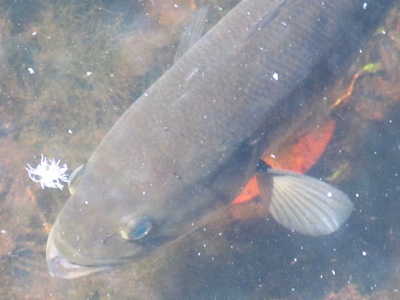Although largemouth bass fishing is usually exciting, there are times when bass simply won’t bite. A number of factors can affect bass fishing, most of which can be identified and compensated for while fishing.
High barometric pressure can be the bane of bass fishermen. During these periods, anglers may experience hot and humid conditions, clear-blue skies, little or no wind, and poor fishing. Although most periods of high pressure occur during the summer, the phenomenon can occur during any season. With modern weather forecasting, these events can be predicted and monitored easily.
Although anglers cannot control the weather, careful planning can sometimes help fishermen to be in the right place at the right time. Although extended periods of high barometric pressure can have adverse effects on fish behavior, weather patterns can change at moment’s notice.
When barometric pressure plunges from high to low with the approach of a new weather system, fishing for largemouth bass can turn on. Some anglers actually watch the weather and plan on fishing during periods when barometric pressure changes suddenly.
Algae blooms are another environmental event that can disrupt fishing for largemouth bass. These events can affect visibility, oxygen levels, and other characteristics. During or after severe algae blooms, “dead zones” may occur in some impoundments.
Aquatic vegetation can impact bass fishing. Although abundant plant growth generally does not cause bass to stop feeding, it can restrict angler access. Anglers can become frustrated as bass feed among dense mats of plants where fishing is nearly impossible.
Debris sometimes hamper largemouth bass fishing. Debris originate from a variety of sources. In some areas, aquatic vegetation may become dislodged from the bottom and float to the surface, fouling lines. Storms or seasonal factors can result in large numbers of leaves or other plant materials covering the surface or littering the bottom.
Hypoxia is a little known phenomenon that can have considerable impacts on bass behavior. Hypoxia occurs when oxygen levels in water fall below tolerable levels. The condition can be caused by a number of factors and may occur throughout the water column or may affect only deep areas. During hypoxic events, fish may move from areas of low oxygen into areas where water conditions are better.
Insect hatches can affect largemouth bass fishing. Typically, the diets of largemouth bass are dominated by fish. Occasionally, bass change behavior, feeding heavily on seasonal hatches of insects. During these feeding periods, conventional tackle may be ignored. Some anglers are able to recognize these conditions and switch over to fly-fishing gear.
Water level changes can occur in some impoundments. In tidal rivers, extreme high or low tides can scatter or relocate fish. In lakes and ponds, droughts or flooding can cause similar challenges. On man made impoundments, dams can alter lake levels considerably. Below dams, water releases can flood areas, stir up sediment, or create strong currents
Run off from snow or rain can also shut down or hamper bass fishing. Excess runoff can reduce water clarity, lowers water temperatures, and can dump an overabundance of food into areas where bass normally feed.
Spawning is one of the most influential and controversial events that can alter largemouth bass behavior. Leading up to the spawning season, largemouth bass tend to feed heavily. Once bass spawn, males remain on their nests, guarding the eggs and newly hatched fry.
During this phase, bass may not feed, but do strike at lures in defense. Considerable research has been undertaken to find out of catch and release fishing is harmful to bedding bass. As with other fishing techniques, anglers often disagree on the ethical implications of targeting largemouth bass that are actively guarding nests.
By recognizing natural phenomena, anglers can adjust their fishing times or alter fishing techniques to compensate for conditions. During poor fishing days, anglers often look for largemouth bass in the following areas:
– in areas where small streams converge into larger rivers or lakes
– under low-hanging limbs
– around downed trees
– in and around tree stumps
– along the edges of spatterdock
– in shallows that have been cleared by wind or strong currents
– in tide or current rips-eddies
